I had written about The First Descendant before, but — wait for it — lost the post in the Great Oopsie of 2023. The good news is that those posts were limited to the testing phases; the more good news is that the game has now officially been released so while it has only been released for about 24 hours, I’ve played a good amount over that 24 hours, and with the time I have put into the earlier tests, I’m going to go ahead and talk about it.
What is The First Descendant
From screenshots and videos, the obvious answer is “shooter”. Looking a little closer, it’s a “looter-shooter”, which is a shooter that rains down things you can pick up from the ground by running over them. The sheer amount of items you can pick up is staggering, which results in an overflowing inventory and hard choices about what to keep and what to sell or deconstruct, and that, IMO, is part of the core game experience. Maybe they should be called “inventory-management-shooters” instead.
In terms of What You Might Know It As, I had been comparing TFD to Destiny, primarily because of the techo-fi setting, humanity-on-the-back-heel narrative, and lots of guns, but while that is true to an extent, the game also shares DNA with Warframe.
Hold up, don’t bail yet. Personally, Warframe never clicked: I didn’t like the designs, and the gogogo mentality and mechanics of the community and game design weren’t palatable to my sensibilities. TFD does have a slight Warframe feel, but it’s not “rush everywhere”, and it trades the parkour mechanics for a more staid grappling hook mechanic which I like a lot more.
How It Plays
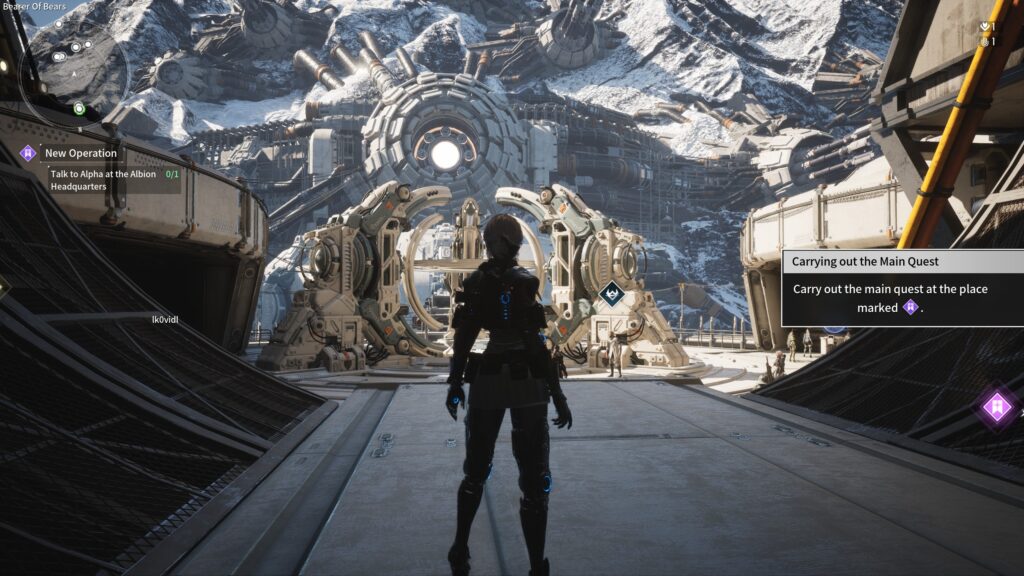
At the start of the game, you get to choose from three Descendants: Viessa, Lepic, and Ajax. Each Descendant has their own gimmick; Viessa uses ice, Lepic has some pretty cool crowd control abilities, and Ajax is a tank so your initial choice covers about 80% of the standard Trinity, I suppose.

The world is broken out into regions, and there are regions within those regions. Those sub-zones contain a series of possible activities represented by beacons (a la Destiny) that you can find and activate to start a mission guidance system. If a mission has been started by someone else, you can either run in and join it or in certain cases the game will teleport you to the front-line. You can also auto-join a mission by entering the mission area and shooting some enemies so that the system assumes you want to be part of the action. During this time you will auto-party with other people, unless you are already partied up with friends (I assume).
Missions
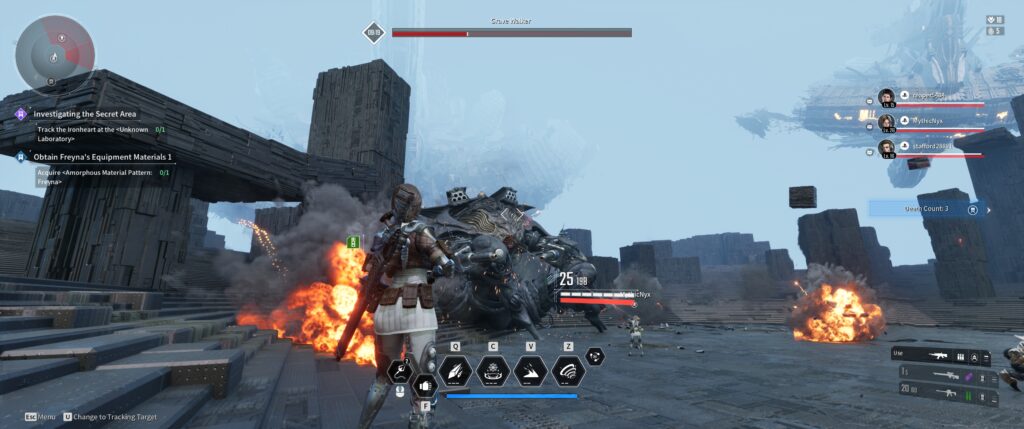
There’s a small variety of missions including defense, collect-the-item, and plain old “kill everything we send at you” varieties and a few others I can’t remember. Each zone covers it’s own part of the story, and the flagged beacons are usually parts of the zone’s narrative objective, culminating in a decently scoped zone boss battle. This is where the ad hoc grouping shines as the zone encounter can use an auto-party system to find other players who are also queuing up for the event. Usually for this level of mission you also have the option to try it solo, but I’m not sure how that plays out: this has been the one game in my long history of gaming where I’ve yet to slap the solo button on anything, and I’m happy to say this has been a pleasing if not never wracking experience not because of the players, but because these battles can be protracted on account of the boss mechanics. So far there’s not been any major deviations, though. The first group mission you’ll get will pit you against “Greg”…I am not joking, the BBEG is named “Greg” which I assume is more badass in Korean than it is in English…who will eventually gains three satellites which offer him a shield. The group will need to concentrate fire on one satellite at a time to take them all out, but if they aren’t shot down fast enough, they will regenerate.
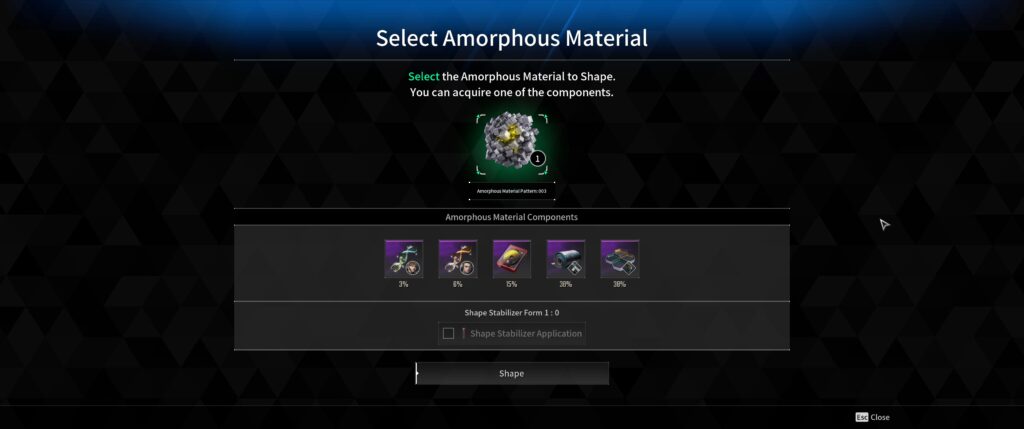
Starting at level 10 and offered as part of your first mission to acquire a new Descendant, you’ll take on a “grave walker” void intercept battle with three other players. You will have done something similar as part of the prologue, but this is the “real deal”. Every dozen levels thereafter, you can up the difficulty by fighting a different void baddie, and these will drop important construction materials for you; what you get is dependent upon a percent chance with the “best” option having the lowest chance (natch). You can tackle the walkers as often as you like, but you’ll only get rewards 2x a day, and to be frank once you out-level the first walker, it ceases to be anything like a challenge.
Advancement
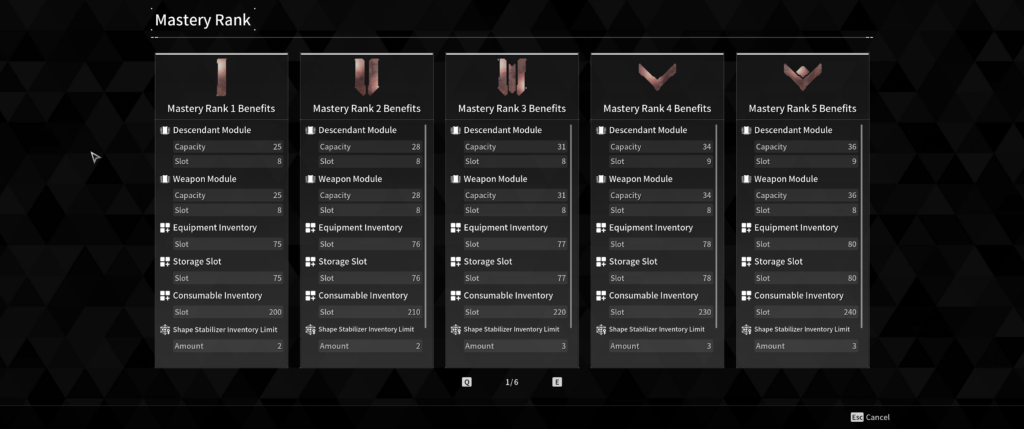
There’s a few advancement tracks in TFD. You’ll have an overall level which is what gates a lot of access, such as to the void intercept missions. Then there’s the mastery level which expands things like inventory and the number of points you have to assign your “module” cards. Then there’s a “season rank” which is mainly important if you purchase their battle pass as each rank up will allow you to claim crafting materials, skins, paints, and weapons, but it’s not so important for everyone who skips that purchase.
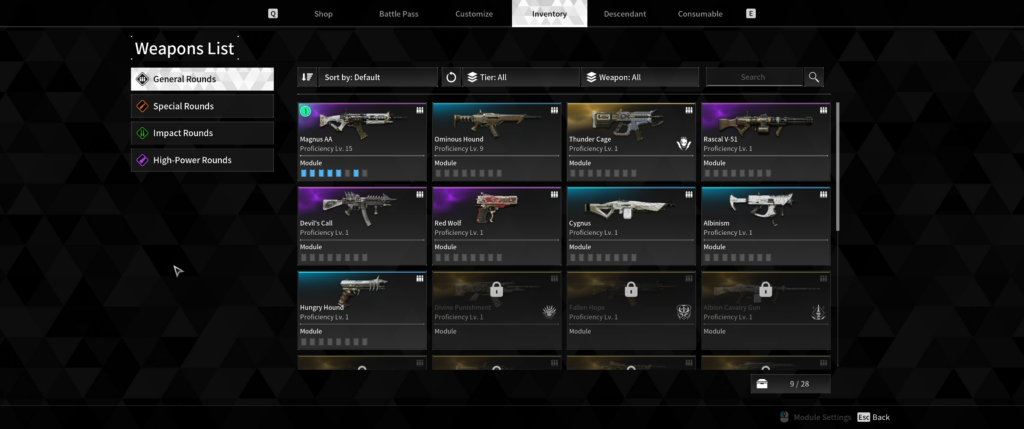
Like Destiny, weapons are “named”, fall into classes, and are organized by ammo type. You will get weapons as drops in the world and in missions, and some “ultimate” versions can be crafted. Unlike Destiny, though, you are free to mix and match whatever weapons suit you using three slots. However, the availability of ammo can be a deciding factor; I have been running without sniper ammo for some time now as it’s not been a common drop for me.
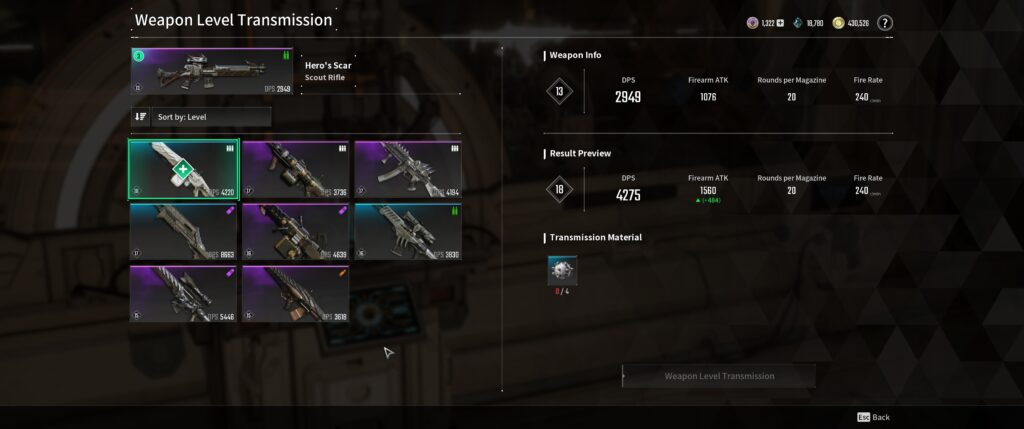
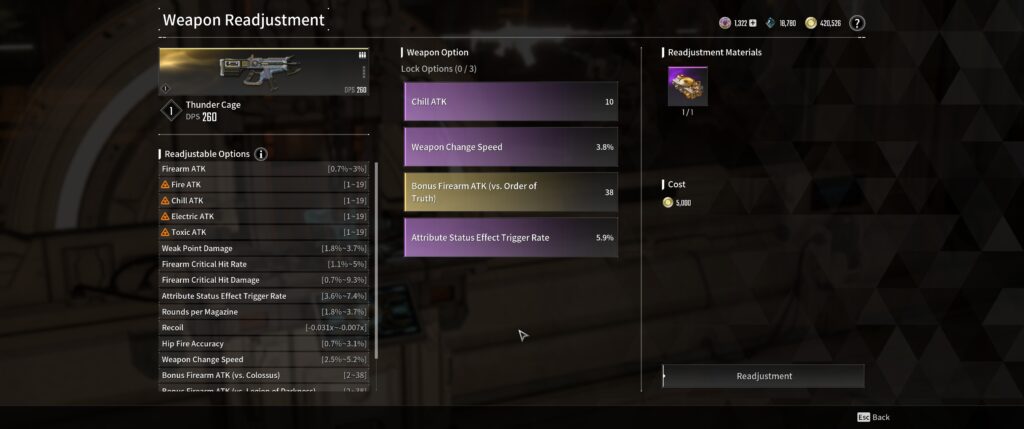
Weapons can be swapped out for items of higher level, DPS, and/or secondary abilities, or they can be leveled up by sacrificing a qualifying weapon of higher level, along with a crafted catalyst. You can also “respec” a weapon’s default perks. Some of the perks can be locked down if you like them, but then you can apply a catalyst and take your chances with a new, random configuration (the % chances of each new perk are displayed for your edification or rage, depending on the outcome).
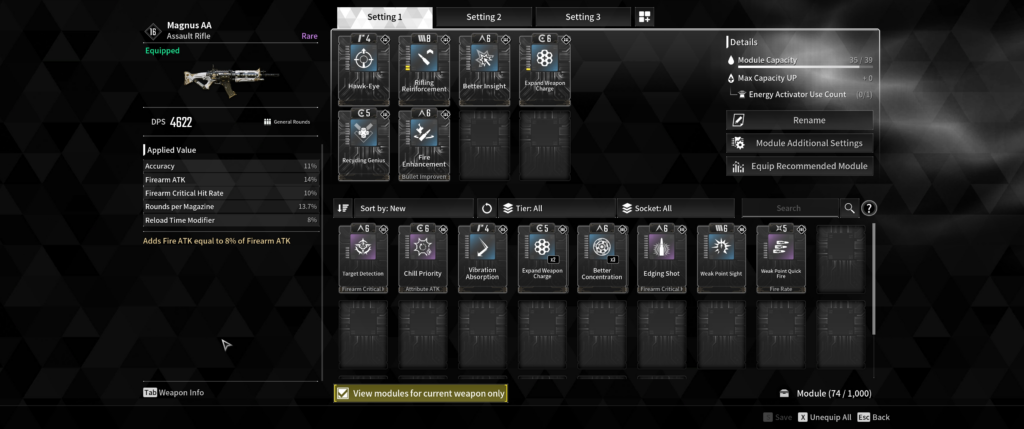
Both weapons and Descendants use “modules”. These cards can have good and bad stats and are either weapon or weapon class specific. Each card also has a value which indicates how many slots it will take up, and the maximum number of slots you have is determined by your Mastery level. Later, you can enhance your favorite modules to make them more effective, but doing so also increases the number of slots the card requires. One excellent feature I’d love to see other games adopt across the board is the “recommendation” system, which takes the top 10% community configurations from successful Grave Walker void intercept battles. While this is a kind of meta, it’s not forcing players to go out and sift through everyone’s opinion of “the best”; it helps folks get up and running quickly by applying statistically proven choices, and I think that’s cool.

Descendants also have two additional gear types: reactors and external components. Any reactor can be used, but the benefits are best when the reactor type matches the Descendant’s ability type. Some reactors also offer percent boosts under certain conditions, like whether or not you’ve equipped an assault rifle, or a shotgun. External components offer buffs to things like shields, HP, and defense, but can also boost gold or equipment drops, or shield regeneration speeds.
Earning and Building Descendants
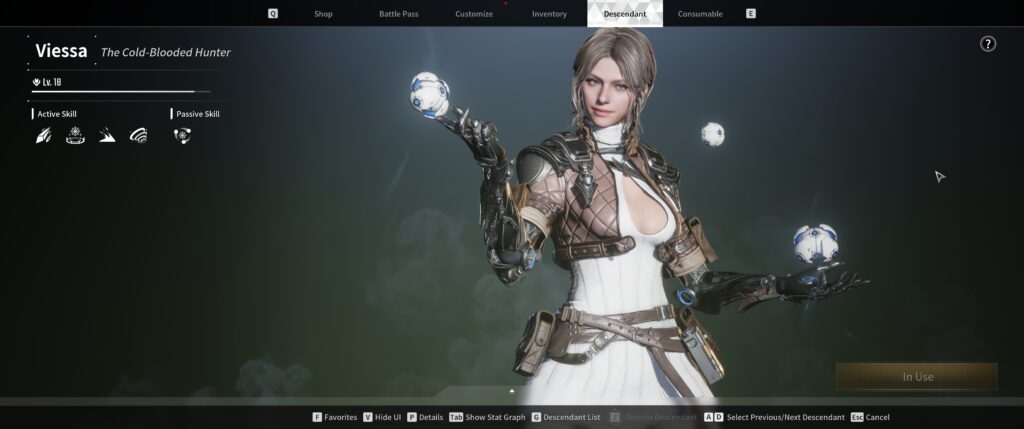
After the initial character select, the game will send you on a mission to “unlock” Bunny as a second Descendant. This involves completing story missions, capped with a void incursion battle. Once you get the parts, you can visit Anais in the Albion hub city and begin construction. When constructing anything, there’s usually a material, gold, and time cost involved. Materials can be found, crafted, or awarded. Gold is just gained as a matter of course. Each construction job takes a set amount of real-world time, either a few minutes or even a few hours, depending on what you’re making.
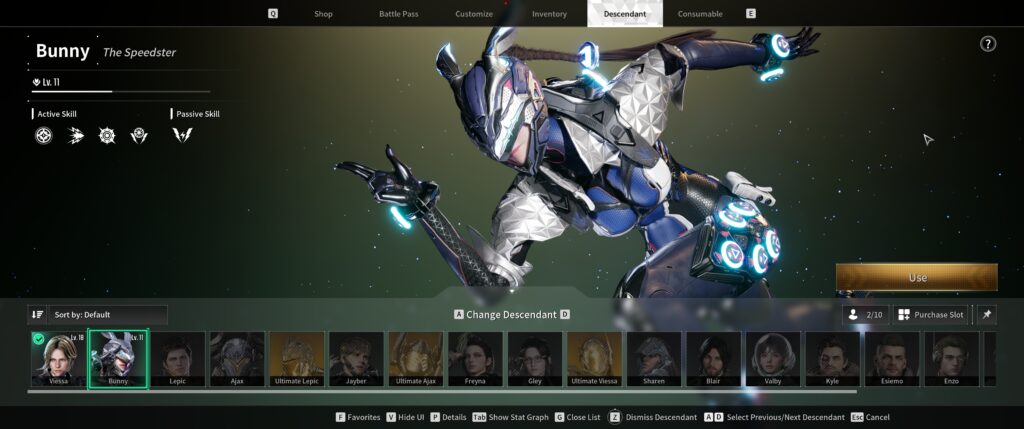
One key observation I have is that whenever you craft a new Descendant, it starts at the level of your primary character. In the screen above, I crafted Bunny when my Viessa was at level 10. My friend Mindstrike made the decision that he wasn’t going to craft Bunny, or any other Descendant, until he was sure he would use them as that would start them off at a much higher level. As for me, I’d have to backtrack and level up my Bunny to catch up with my Viessa.
One real pain in the ass feature is that when you swap between Descendants, the loadout does not change. For weapons, this might be OK, but for modules, reactors, and components, this is monumentally frustrating. What works for Viessa — who is ice — does not work for Bunny — who is electrical — so not only do I have to swap certain aspects when changing characters, but I have to remember not to deconstruct the other character’s stuff in between. Sadly, there doesn’t seem to be a way to “lock” items from sale or deconstruction, but we can set presets. A preset can store a Descendant, weapons, reactors, and components, but they aren’t tied to the character; we have to remember to reload them when switching Descendants. This is way more onerous than it should be, so I’ve been sticking primarily with Viessa.
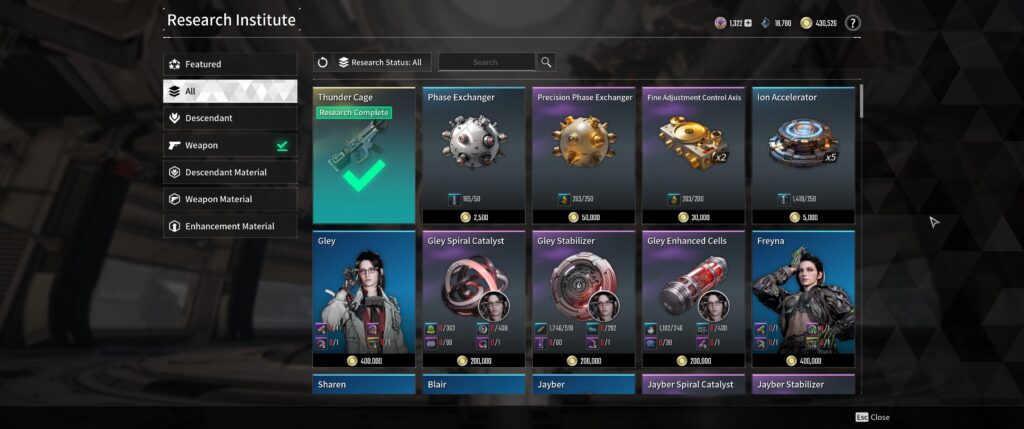
Note that the materials needed to construct a Descendant aren’t readily available. You can look at Anais’ menus, find the character, weapon, or item you want to construct and click on each material. It will explain where you might get that material, and some might be in zones you haven’t yet unlocked.
And this brings us to the discussion of the cash shop.
Cash Shop and Battle Pass
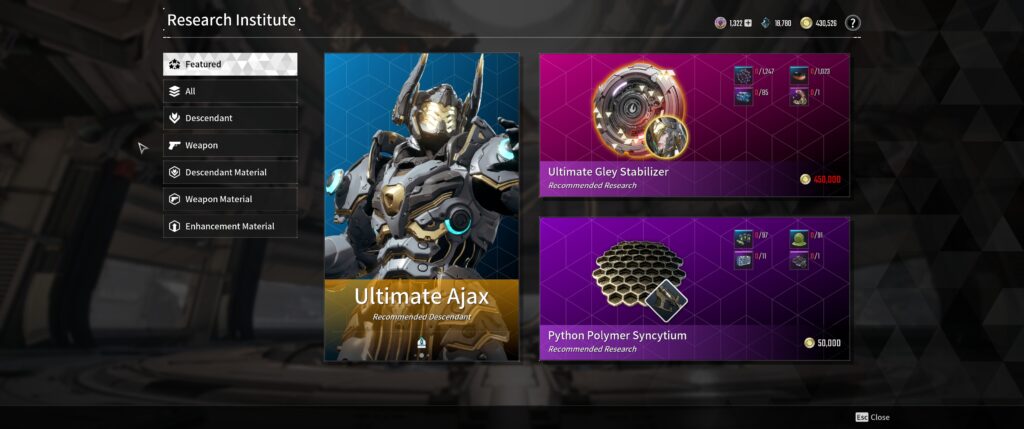
TFD is free to play, and if you never spend any money in the game you will be able to be successful, competent in groups, and will eventually earn everything you need to build your way through the Descendant roster. For those who can’t wait, have extra money, or want to support the game financially, there is, of course, a cash shop.
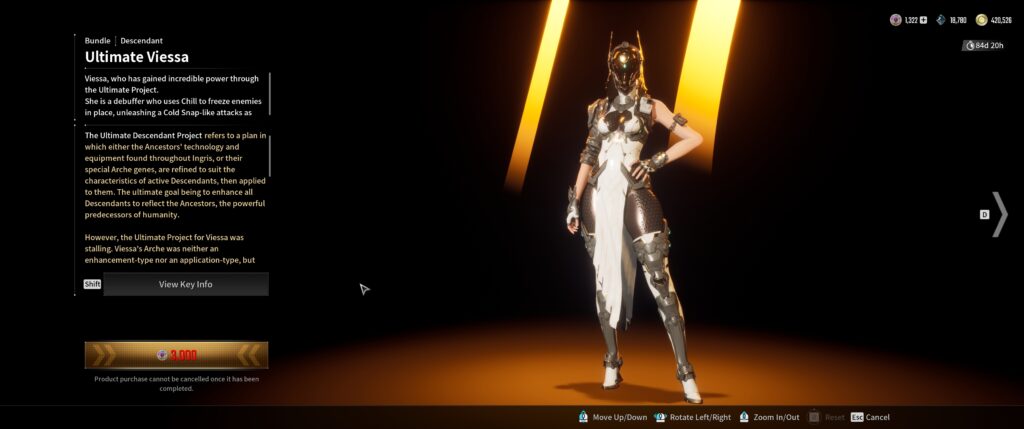
Now, normally I’m pretty blasé about RMT in games, especially F2P games, but that’s just me. I am willing to support a game I enjoy, and I am fortunate enough to have some spare cash to use. Games like Guild Wars 2 offer a lot of convenience and appearance items that people love, and folks seem OK with that. TFD offers those things too, but it also allows players to buy Descendants directly (but not weapons). On one hand, I’m OK with this because it’s not PvP so the only “win” condition is how a purchase makes a person feel about their satisfaction with, and ability to, play a game they enjoy. On the other hand, I feel that this is a bit too much bait to get people to spend money. Again, I know that in order to keep the game going Nexon needs to bring in the cash, and they chose to do so with an in-game market, but their configuration feels like they are pushing some people to spend money they otherwise would not. Ultimately, everyone can have what can be bought through hard work, but I’m not sure exactly how I feel about selling characters directly.
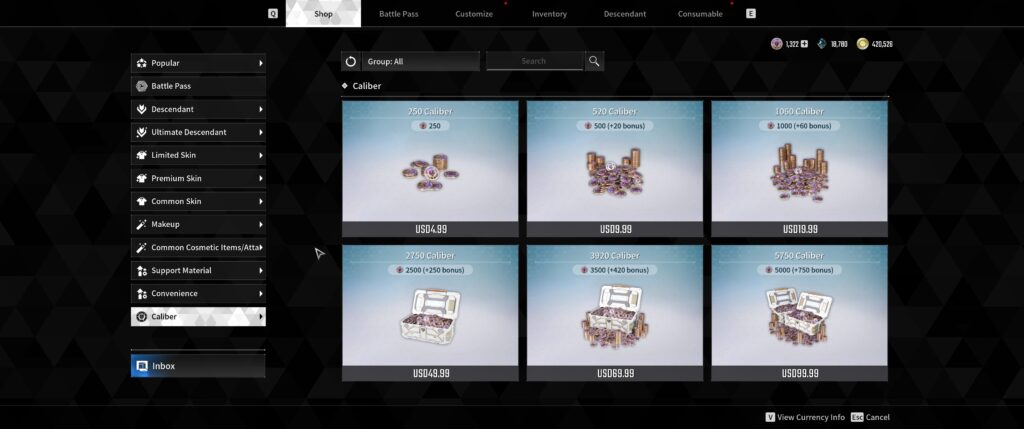
The RMT cash is called “Caliber” and comes in denominations that I believe are pretty on-par with this kind of setup. Everything is relative, though: I could buy Lepic or Ajax for 300 Caliber which, as you can see from the graphic above, would require me to pay about $10USD (companies never offer a package that can hit a target directly, of course, forcing overspend and resulting in enough leftover currency that starts a chain-reaction to make up shortfalls in the future). Some basic Descendants can be had for 900C, which, again, pushes the spend up a tier to the $20USD level.
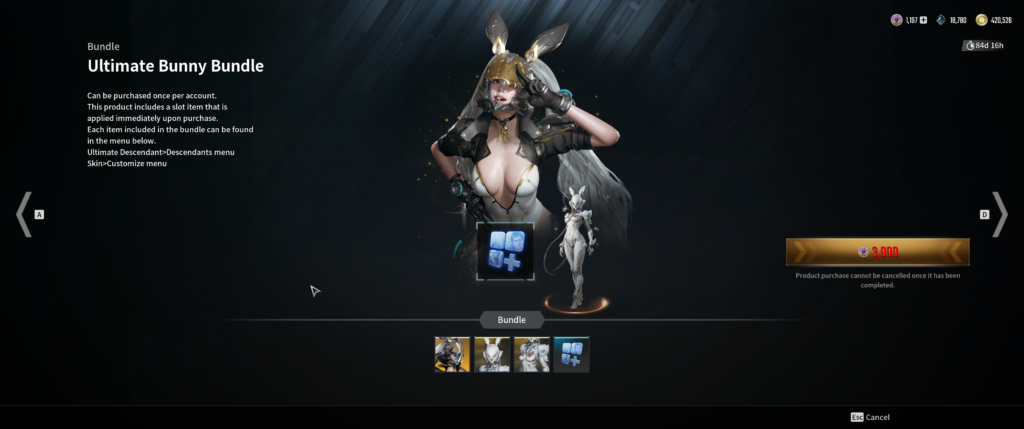
Then there’s the “Ultimate Descendant” option. These are “enhanced” versions of the standard counterparts, and this is a little vague as the store doesn’t explain what an ultimate version offers over the standard. Ultimate Descendants can also be crafted, but word on the street is that the materials to do so only have something like a 1% drop rate in the places they can be had. The store page for the ultimates offers bundles ranging from 3000C to 5000C which, yes, starts you off at about $70USD if you want one in a single transaction. Of note, though: I have seen a lot of people on the game’s Discord assuming that the ultimate version of a character is just a skin, which it so obviously is not. While each ultimate option comes with a skin, it also comes with a variation of the character which has its own advancement track that does not replace the original standard character.
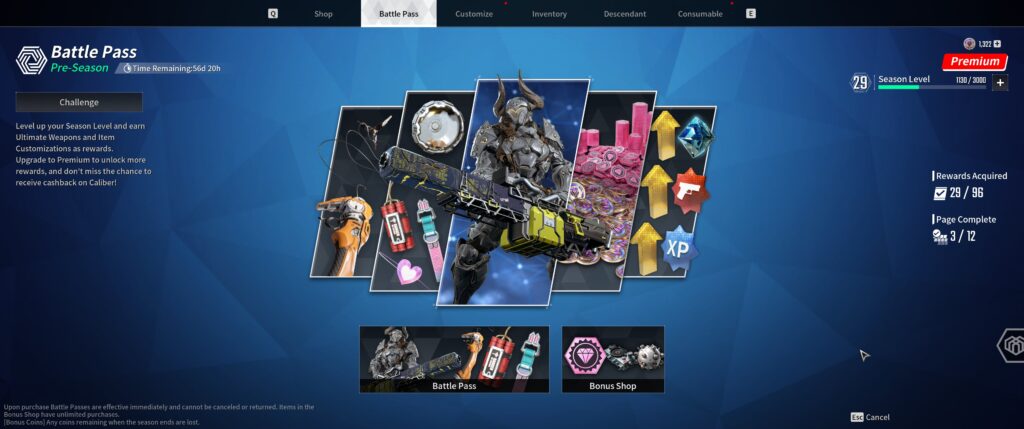
Then there’s the battle pass. For about $50USD, you unlock a track of items which can be claimed at every season level — not character level or mastery rank, mind you. These are primarily cosmetic items, paints, or skins, but also include an occasional injection of Caliber, boosts to earnings of non-premium currency or XP, and weapons. The season track runs all the way up to level 96, and a “season” runs for two months (according to the timer at the top of the battle pass page).
I did purchase the battle pass because I really enjoy the game and I thought that this was a straightforward way to get a wide variety of “stuff” in exchange for my support. Upon closer inspection, however, I’m not convinced that this is worthwhile. The rewards are pretty good, but amount to “fun” stuff as opposed to really “useful” stuff. Cosmetics are nice, boosts are nice, and the occasional Caliber is nice, but I can do without emotes and some of the…choices Nexon has put on offer. I also know that me being me, the likelihood that I’ll reach season level 96 in 60 days is slim; others can probably blow through it, but I probably won’t. Add to that the fact that the battle pass is finite, and I assume would need to be “renewed” after each expiration, and that would be a big “no thanks” from me going forward. I did it once, I will collect my stuff, but I won’t be doing it again.
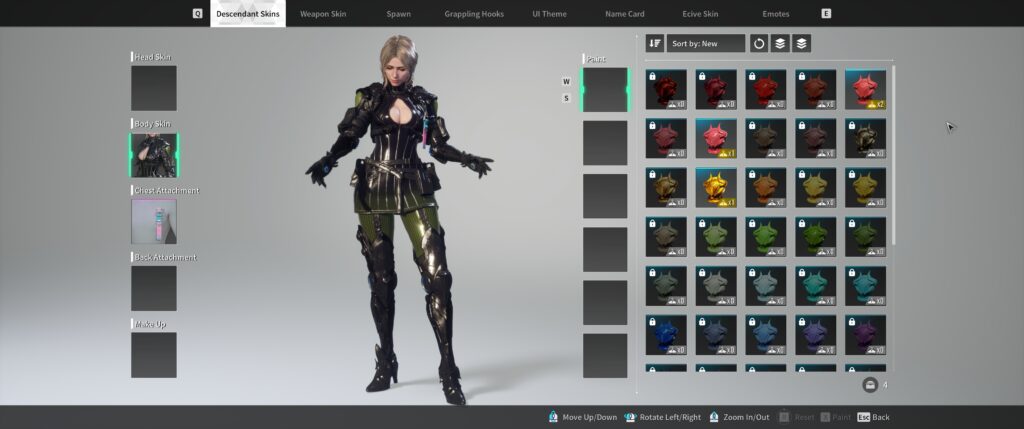
This is one of the first cash shops that has caused me to lean more towards the nope side of the spectrum simply on account of the so-easy-even-I-can-calculate-the-disparity on display here. Based on what I’m seeing in Discord, though, this is not a universal sentiment. And for a supporter of Star Citizen, this is saying something.
What’s Left
Not all that much, I don’t think. The community has been pretty good; the game features an option to prevent non-friends or non-party members from messaging you directly, and VOIP can be turned off entirely, so it’s possible to do your best and not hear anyone’s opinion of it, which is really nice. I have always been a fan of the “drop in” mission mechanic and it works exceedingly well here. I’ve even decided to use the auto-party option for the zone set-piece battles and it’s been pleasant thus far.
One thing on my mind that Mindstrike brought up as I was watching him on Discord as he got started last night is that this is a pretty linear game, and with all linear, online games, there’s got to be a reason for advanced players to revisit less advanced areas to help late-bloomers with some of the content that’s keyed to group participation. I’m not sure if TFD has those incentives. The need to farm mats for Descendants, weapons, and other items is certainly one, but as those seem to be strung out parallel to general advancement means that once a player has earned those mats, the incentive to go back to lower level zones is gone. I’m hoping that the drop rates might force players to stick around the lower levels longer — a win for low-level players — or it might drive frustrated players to the cash shop — a win for Nexon but no one else. Maybe TFD could use a “mentor” or “guide” system which rewards higher-level players for helping out lower-level players, or maybe this concern is all smoke and no fire. Time will tell.
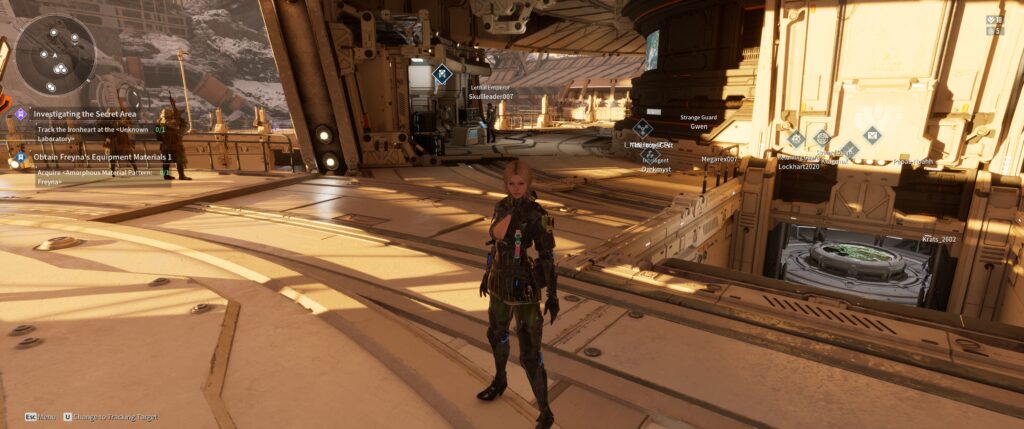
I am enjoying the gameplay, and the combat seems really solid. There are rare lag spikes, and when I say rare I mean I have only encountered two in the (checks Steam) 7.1 hours I’ve played thus far. One thing I neglected to mention is that the game is cross-play native, so Albion is filled with Steam, Xbox, and PS players who can group up seamlessly to hopefully keep the world populated and running smoothly.

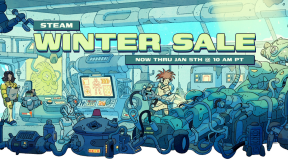
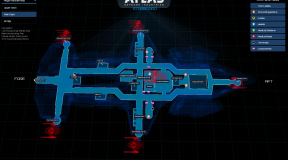
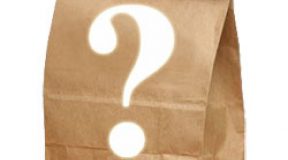
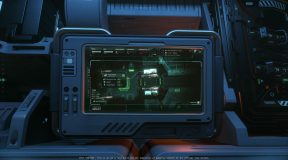
1 Comment
Naithin
July 6, 2024 - 9:51 pmAfter having rather lack lustre thoughts about the game during an earlier test experience, I’ve found the game significantly more fun this go around — although to be fair, I’d put that largely down to having a small group of friends that has also jumped in with me.
I share your annoyance of Descendants not having their own individualised load outs as well. Further exacerbated, like you said, but not having the gear equipped auto lock (or even at least warn you) if you try to feed it into the auto dismantle chipper.
You *can* mark items to be locked though, but only while they’re in your inventory — not while equipped. Using KB+M on PC, the shortcut is ‘U’ while mousing over the item in question from memory. So if you’ve already got the gear equipped, you’ll need to collect another piece for the slot, switch it out, mark the one you want as an attached/favourite, then put it back on. >.<
You can then use presets (you only get 2 starting out though) to handle the equipping, but those also don't appear to lock down gear at the moment.
I don't really understand how TFD got all the way to launch with this being the case, but ah well.
Comments are closed.